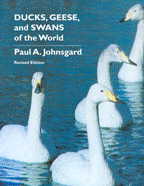Papers in the Biological Sciences

Ducks, Geese, and Swans of the World by Paul A. Johnsgard
Date of this Version
2010
Document Type
Book Chapter
Abstract
Spur-winged Goose
Muscovy Duck
White-winged Wood Duck
Comb Duck
Hartlaub Duck
Green Pygmy Goose
Cotton Pygmy Goose
African Pygmy Goose
Ringed Teal
North American Wood Duck
Mandarin Duck
Australian Wood Duck
Brazilian Teal
This group of 13 species of primarily perching waterfowl is a rather heterogeneous assemblage of birds that are not easily characterized. In addition to being generally perching and cavity-nesting, they also have fairly wide, rounded wings, elongated tails, and sometimes also relatively long legs. Many of the species exhibit a great deal of iridescent coloration in their plumage, even among females, and in a few species nearly the entire body plumage is iridescent. In some of these brilliantly colored forms, such as the comb duck, muscovy duck, and the spur-winged goose, there is a great difference in the sizes of the sexes even though they may be very similar in plumage patterning. In spite of their brilliant plumages, males of only a few of the species exhibit definite eclipse plumages, probably in part because most of the forms are tropical, with long or irregular breeding seasons. Pair bonding is generally seasonally established in the species that breed in temperate climates, while in the more tropical and seemingly more primitive species the pair bonds are weak and in a few cases apparently even nonexistent. The patterns of the downy young are typically well marked and characterized by white or yellow spots and stripes on a darker background; in many species they are not readily separable from the downy young of dabbling ducks. The two tribes are obviously closely related, and taxonomists are not agreed on which group some species such as the ringed teal, pink-eared duck, and Brazilian teal should be included in. However, to merge the tribes would make a comparatively large tribe and tend to obscure the well-defined differences in the behavior patterns and breeding biologies of these two groups.


Comments
In Ducks, Geese, and Swans of the World, by Paul A. Johnsgard. Electronic edition copyright © 2010 Paul A. Johnsgard.